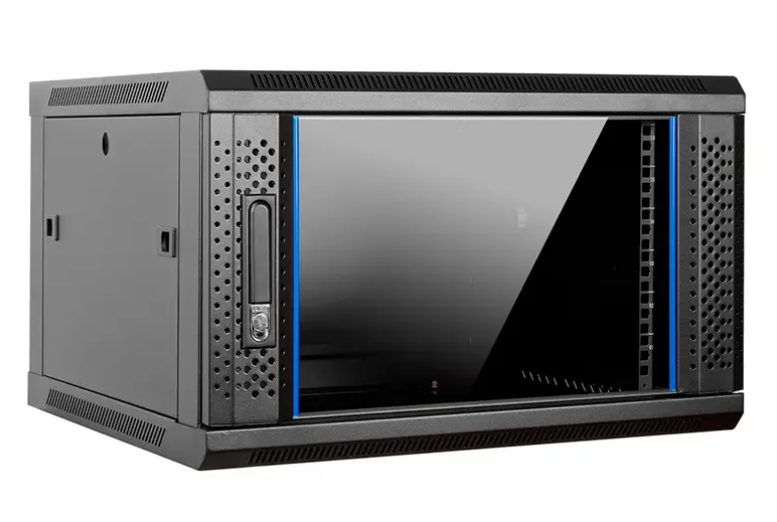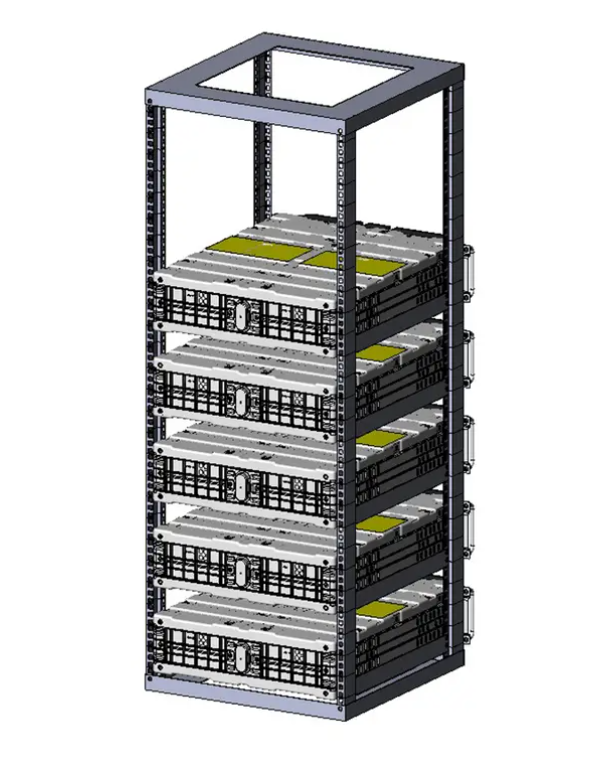Are you struggling to choose between enclosed wall cabinets and open-frame racks for your network equipment? The right storage solution can impact your equipment's performance and security. In this post, we'll explore the pros and cons of each option, helping you decide which is best for your needs. Whether you prioritize security, airflow, or ease of access, we'll guide you through the decision-making process.
Understanding Enclosed Wall Cabinets and Open-Frame Racks
Enclosed wall cabinets are secure storage units with solid walls, often including lockable doors to protect your equipment from dust, debris, and unauthorized access. Made from durable materials like cold-rolled steel, they help keep your devices safe and reduce noise in office or data center environments. Common sizes range from 18U to 27U, depending on your storage needs.
On the other hand, open-frame racks are minimalist solutions that offer superior airflow and easy access to your equipment. Without walls, they allow for better heat dissipation and make maintenance simpler. Open-frame racks come in larger sizes such as 24U, 32U, and 42U and are typically made from sturdy steel or aluminum to support heavy equipment.
Key Differences Between Enclosed Wall Cabinets and Open-Frame Racks
Comparison of Installation and Setup
Enclosed Wall Cabinets
Installing enclosed wall cabinets can be more complex due to mounting options and the need to ensure the cabinet is securely attached. The setup may require additional effort, especially when handling heavier equipment or dealing with smaller spaces. Proper installation is essential to ensure security and functionality.
Open-Frame Racks
Open-frame racks are generally easier to install. They often feature simple mounting options, and their design allows for easy mobility. With fewer restrictions, you can quickly move or adjust them based on your needs, making the setup process much more straightforward.
Space Efficiency and Size Considerations
Enclosed Wall Cabinets
Enclosed wall cabinets have a space-saving design but come in limited sizes, such as 18U, 22U, and 27U. They are ideal for smaller setups or where conserving floor space is essential. However, the smaller size options may not be suitable if you need to accommodate larger amounts of equipment.
Open-Frame Racks
Open-frame racks offer larger sizes, like 24U, 32U, 36U, and 42U, which can house more equipment. These racks are perfect for larger setups where you need to store a substantial amount of networking gear. However, they require more floor space, making them less suitable for tight areas.
Security and Safety Features
Enclosed Cabinets
One of the main advantages of enclosed cabinets is enhanced security. Lockable doors provide physical protection, reducing the risk of unauthorized access. This is especially important in environments where security is a high priority, such as data centers or server rooms with sensitive information.
Open-Frame Racks
While open-frame racks provide easy access to your equipment, they offer less protection against theft or unauthorized access. Without lockable doors, they are more vulnerable to being tampered with or accessed by individuals who shouldn't have entry to the equipment.
Maintenance and Accessibility
Enclosed Cabinets
Enclosed cabinets can make regular maintenance more challenging. With limited access points, it may take longer to troubleshoot, upgrade, or replace equipment. For ongoing support and adjustments, the process can be more cumbersome and time-consuming.
Open-Frame Racks
Open-frame racks excel in terms of accessibility. With their open design, maintenance, upgrades, and troubleshooting can be done quickly and easily. There's no need to open doors or remove panels, allowing for faster interventions when equipment needs attention.

Which Type of Rack Is Right for Your Equipment?
Equipment That Benefits Most from Enclosed Wall Cabinets
Servers
Servers require physical protection and noise reduction. Enclosed cabinets help secure them from external elements like dust and provide a quieter environment, which is critical for high-performance servers.
Network Switches
Network switches often produce considerable noise. Placing them in an enclosed cabinet reduces this noise, while also offering physical security against unauthorized access.
Storage Arrays and Backup Devices
Sensitive data stored in storage arrays or backup devices needs protection. Enclosed wall cabinets ensure these devices are shielded from damage, while reducing the risk of tampering or theft.
Security Appliances
Security appliances, such as firewalls or intrusion detection systems, need to be protected from physical threats. Enclosed cabinets keep them secure, ensuring that important security configurations and logs remain safe.
Equipment That Benefits Most from Open-Frame Racks
Network Switches
Network switches benefit from open-frame racks because they require good ventilation to prevent overheating. Open-frame racks offer unobstructed airflow, which is essential for devices that generate heat.
Patch Panels
Patch panels are often used for cable management. Open-frame racks make it easy to organize and access cables, improving the maintenance and efficiency of network setups.
Power Distribution Units (PDUs)
PDUs distribute power to your networking equipment. Open-frame racks provide easy access to PDUs, while ensuring proper airflow around them to prevent overheating and maintain optimal performance.
Audio/Video Equipment
Audio and video equipment requires quick access and efficient cooling. Open-frame racks are ideal for this because they allow for better airflow and provide immediate access to components for maintenance or upgrades.
Test Equipment
Tools like network analyzers or cable testers need to be easily accessible for troubleshooting. Open-frame racks make it simple for technicians to quickly connect and test equipment, making maintenance much more efficient.

Making the Right Choice: Which Is Best for You?
Factors to Consider When Choosing Between Enclosed Cabinets and Open-Frame Racks
When deciding between enclosed wall cabinets and open-frame racks, there are several key factors to consider:
Equipment Type: What type of equipment will you be housing? Servers, network switches, storage devices, and other sensitive equipment often benefit from enclosed cabinets for added protection. However, if you have devices that need better airflow, open-frame racks might be the better choice.
Security Needs: Consider how much protection your devices need. Enclosed cabinets offer lockable doors and greater physical security, making them ideal for high-security environments. Open-frame racks, on the other hand, provide no security from unauthorized access but are easier to maintain and access.
Space Considerations: Do you need to save floor space? Wall-mounted racks are great for freeing up floor area and are ideal if you're dealing with limited space. If you need to store heavier equipment, floor-standing open-frame racks might be a better fit.
Budget: Enclosed cabinets are generally more expensive due to their added features like lockable doors and better physical protection. If you're working within a tighter budget, open-frame racks offer a more cost-effective solution while still providing essential functionality.
Cooling Requirements: Proper ventilation is crucial for network equipment. Open-frame racks naturally allow for better airflow and heat dissipation. If your devices generate a lot of heat, you may want to opt for open-frame racks. Enclosed cabinets may require additional fans or ventilation systems to maintain optimal cooling.
When to Choose Enclosed Wall Cabinets
Enclosed wall cabinets are ideal in the following situations:
Sensitive Data: If you're storing critical or sensitive data, physical security is a must. Enclosed cabinets provide a secure environment, reducing the risk of unauthorized access or tampering.
High-Value Equipment: For high-value devices such as servers and storage arrays, enclosed cabinets offer protection from dust, physical damage, and other environmental factors that could reduce their lifespan.
Security Concerns: In environments where security is a top priority, like data centers or office networks, the lockable doors on an enclosed cabinet provide an extra layer of protection.
Noise-Sensitive Environments: If the operational noise of your equipment is a concern, enclosed cabinets help reduce noise, creating a quieter work environment.
When to Choose Open-Frame Racks
Open-frame racks are suitable in these scenarios:
Budget-Conscious Environments: If you're working on a tight budget, open-frame racks provide a cost-effective solution without sacrificing essential functionality.
Devices That Benefit from Airflow: Open-frame racks offer superior airflow, making them ideal for devices that generate a lot of heat, like network switches and power distribution units.
Ease of Access and Maintenance: Open-frame racks provide easy access to your equipment, which is crucial for quick maintenance, troubleshooting, and upgrades. If your setup requires frequent changes or checks, an open-frame rack might be the better choice.
Conclusion
When choosing between enclosed wall cabinets and open-frame racks, consider security, airflow, cost, and maintenance. Enclosed cabinets offer better protection and noise reduction, while open-frame racks provide superior airflow and cost savings. Choose the right rack based on your equipment type and space requirements. If you need further advice, don't hesitate to contact WebiT to help you make the best choice for your needs.
FAQ
Q: Are enclosed wall cabinets better for security?
A: Yes, enclosed cabinets offer better security due to lockable doors and solid walls, which prevent unauthorized access.
Q: Can open-frame racks be used for sensitive equipment?
A: Open-frame racks are not ideal for sensitive equipment as they provide less physical protection from dust, debris, and damage.
Q: Do enclosed wall cabinets need extra cooling systems?
A: Yes, enclosed cabinets may require additional ventilation or forced fans to ensure proper airflow and avoid overheating.
Q: Can open-frame racks be placed in any environment?
A: Open-frame racks are best for controlled environments where protection from physical damage and security are less of a concern.
Q: Which type of rack is more affordable?
A: Open-frame racks are generally more affordable compared to enclosed cabinets due to their simpler design and fewer features.

















